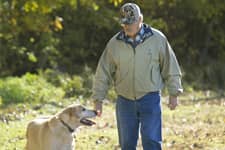
Late fall into early winter, you’ll likely find Rock Island resident, Tim Reagan, 72, in the local woods hunting with his pal, Hank. Whether it’s ducks, pheasants or a friendly game of fetch, Tim prefers enjoying the outdoors with Hank, his purebred Yellow Labrador Retriever, rather than missing the hunting season in sedentary retirement and hip pain.
 “I’ve been active my whole life, and I’m not going to slow down now,” affirms Tim. He is back and pursuing his favorite past times after total hip surgery. “My hip just wore out,” he says. “As a young man, I played in 15 world fast-pitch softball tournaments and have always liked to bike, play golf and hunt. My right hip was starting to get painful when I walked, and I knew it just wasn’t old age.”
“I’ve been active my whole life, and I’m not going to slow down now,” affirms Tim. He is back and pursuing his favorite past times after total hip surgery. “My hip just wore out,” he says. “As a young man, I played in 15 world fast-pitch softball tournaments and have always liked to bike, play golf and hunt. My right hip was starting to get painful when I walked, and I knew it just wasn’t old age.”
Tim’s physician, Quad-City ORA total joint surgeon, Dr. Edward Connolly, recommended a total hip replacement after x-rays revealed significant wear on Tim’s hip from years of arthritis.
“The body’s response to wear and tear is to grow more joint tissue, which can lead to painful bone spurs,” explains Dr. Connolly. Advancements in total joint replacement have made the procedure an option to restore a patient’s quality of life.
“I was not going to put off the surgery. I was in the hospital only two days and walking the same day of the procedure. I was playing golf about six weeks later. There’s no more pain, and I can’t even tell I’ve got a new hip,” says Tim.
Advancements in total joint surgery
Tim’s quick recovery is due, in part, to advancements in total joint replacement. The surgical techniques as well as the total joint replacement components are designed to meet the demand of active patients, like Tim.

“As the largest ball and socket joint, the hip joint serves an important function. A total hip replacement involves removing all the damaged bone and cartilage within the joint, and replacing them with a new prosthetic implant,” explains Dr. Connolly.
“The new hip joint, consisting of a metal cup in the patient’s hip socket along with a metal stem in the patient’s femur with a ball attached, allows the patient to regain a smooth and fluid range of motion.”
Each year, ORA leads the Quad Cities in total joint procedures, performing approximately 1,900 total joint replacements annually. Dr. Connolly, who has been performing total joint and hip replacements for 19 years, says advances have reduced pain, hospital stays, and recovery time.
“Many patients are in the hospital two days or less. We’ve also cut the incision length and recovery time in half,” he says. “People are back doing the things they love in about six weeks instead of three months. The pain they had before the surgery is usually gone in the first few days. It truly makes a meaningful difference in our patient’s lives.”
How do you know if you need a hip replacement?
“The typical symptom is pain in the groin area that radiates through the thigh,” explains Dr. Connolly. “Over time, patients say they can’t tie their shoes without pain, as they begin to experience increasing hip stiffness. They may also have trouble sleeping.”
For Tim, he says he’s glad he didn’t wait too long. “I love being outside. I try to bike about 15 miles a week, and Hank and I walk every day and cover at least 10 miles a week,” says Tim, as he throws yet another stick for Hank to fetch. “He’s just such a great dog. My new hip has allowed us to spend more time together. He really keeps me moving.”
For more information on our Spine Center and ORA Orthopedics, Like us on Facebook and follow us on Twitter.
